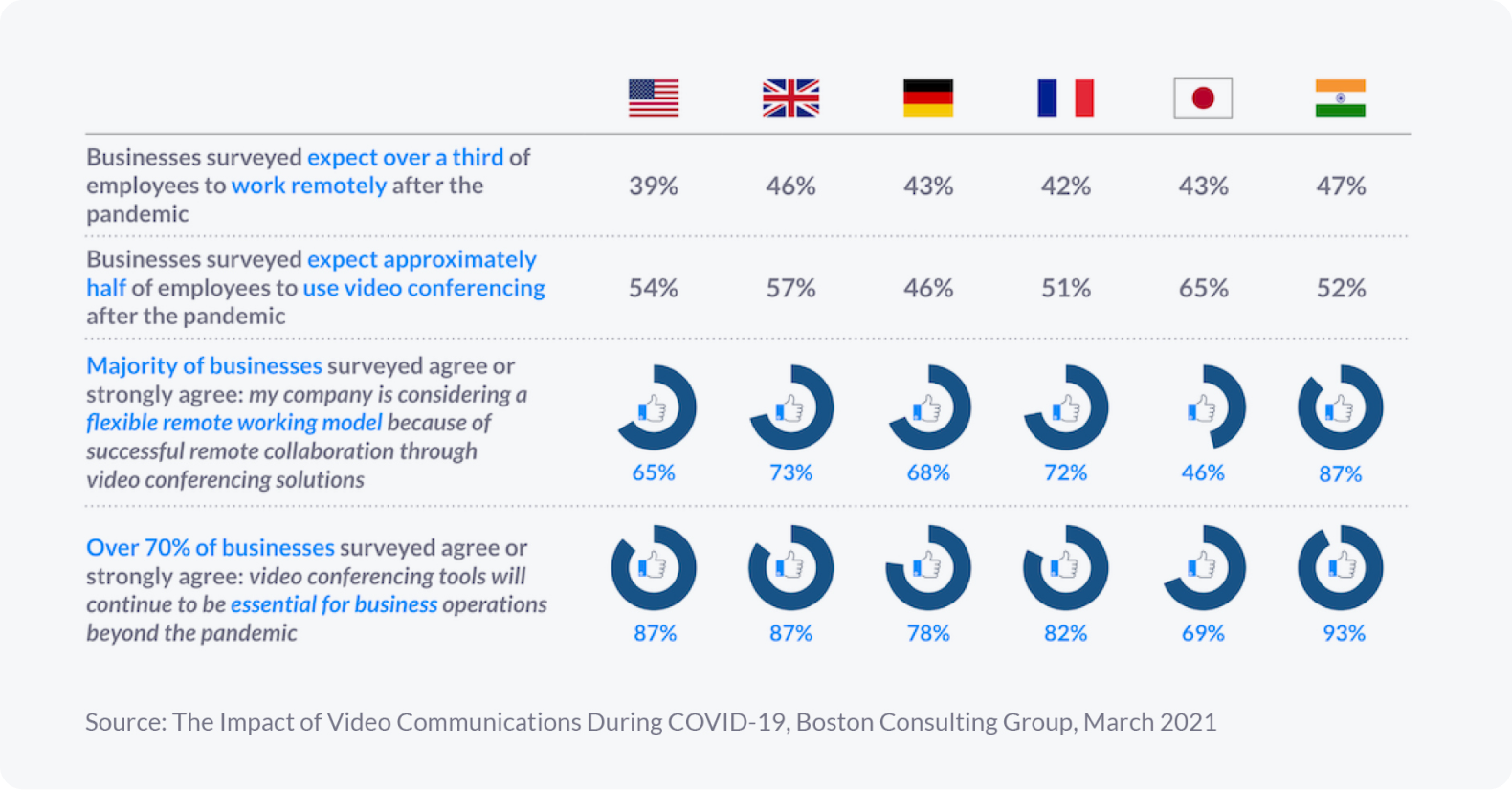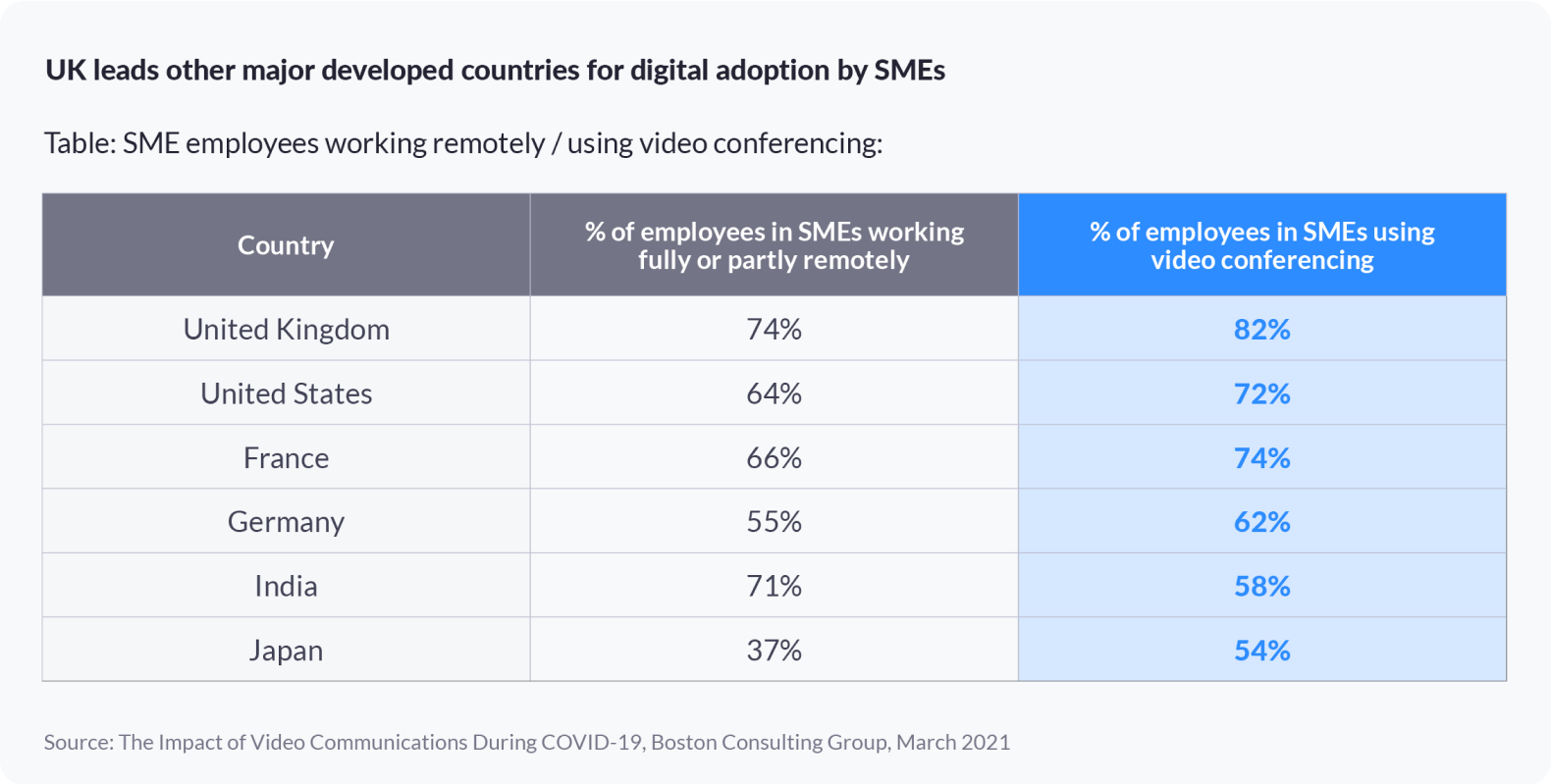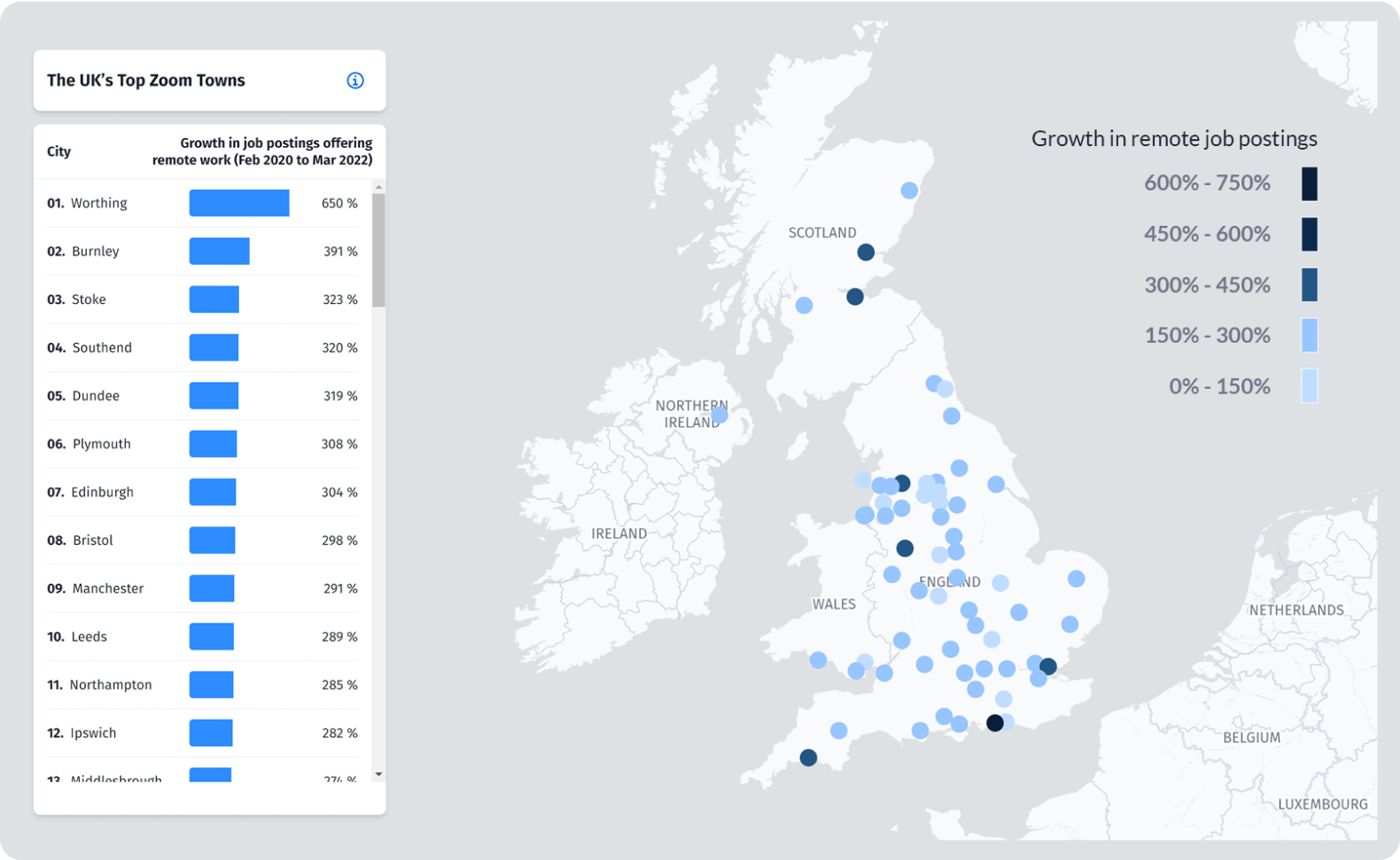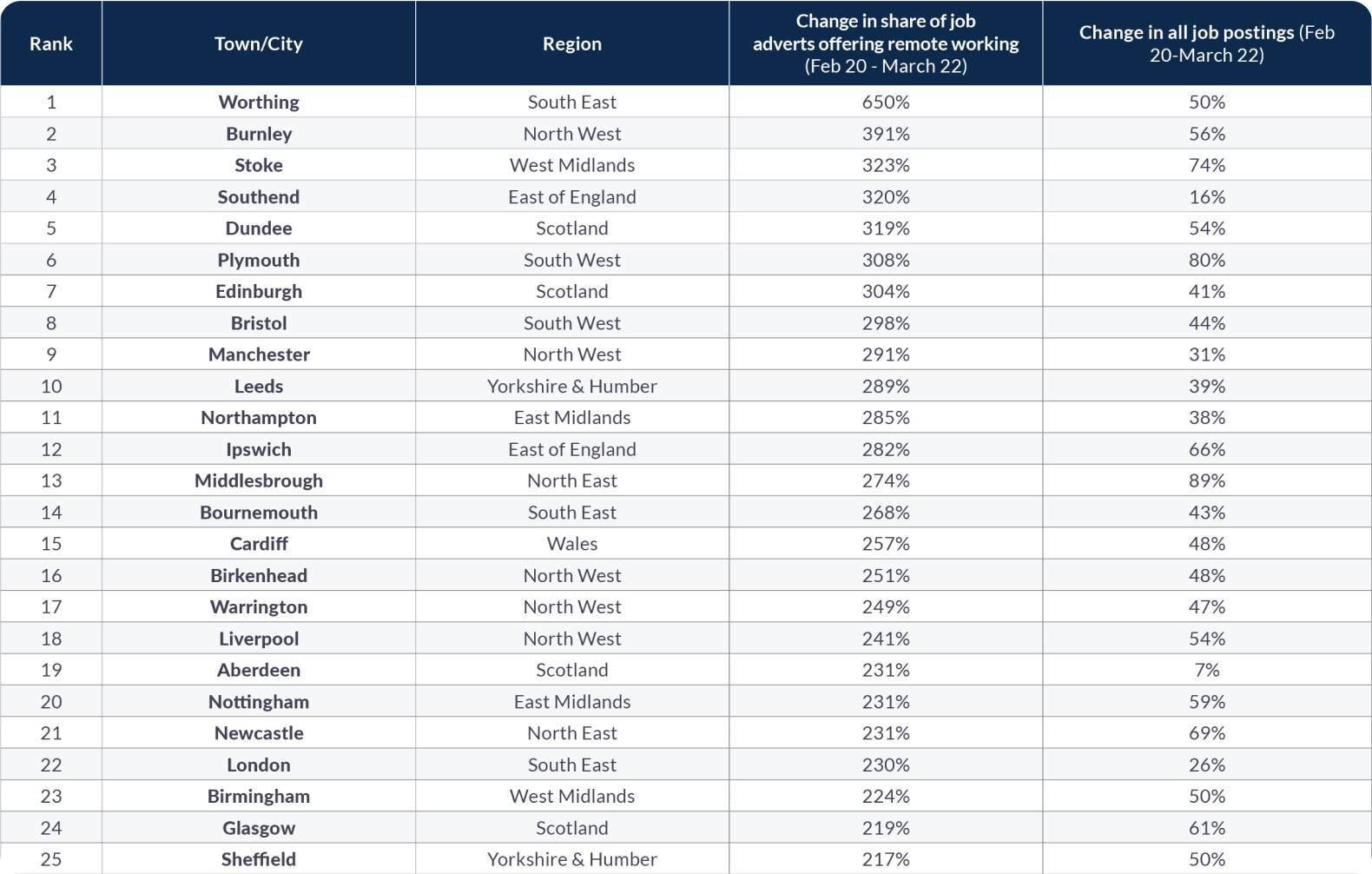The hybrid advantage: how and why the UK can strive to become the world leader in hybrid work
Building Forward with Hybrid Work Models in the UK

- 01 How the UK adapted quickly - Jumplink to How the UK adapted quickly
- 02 Opportunities in the UK - Jumplink to Opportunities in the UK
- 03 A new way forward - Jumplink to A new way forward
- 04 Building forward with hybrid workplaces: the benefits to the UK - Jumplink to Building forward with hybrid workplaces: the benefits to the UK
- 05 How the UK can build forward and cement its status as a world leader in hybrid work. - Jumplink to How the UK can build forward and cement its status as a world leader in hybrid work.
- 06 Annex: best practices for hybrid work - Jumplink to Annex: best practices for hybrid work
- 07 About Zoom - Jumplink to About Zoom
Foreword
For years, technology has been changing people’s relationships with the workplace and how they connect with their colleagues. It was this constant evolution that led to the formation of Zoom in 2011 because we felt there was a better way for people to communicate and collaborate at work.
The pandemic accelerated that change at an unprecedented rate. We are proud of the fact that Zoom was the most downloaded app in the UK in 2020 and one of the most commonly used video conferencing tool during the pandemic, but this was an acceleration of changes already underway – a decade’s worth of digital adoption took place in the UK in 12 months.1
This has helped lead to a dramatic shift in public expectations of how, when, and where people work. Hybrid working is favoured by 85% of those who worked from home during the pandemic, and 57% of UK employees are expected to work from home at least some of the time by October 2022 — when the Office for National Statistics expects the UK economy to have established a post-COVID ‘new normal.’2 Employers have also recognised the need to adapt their working practices to remain competitive and attract and retain talent, with a survey by the Institute for Directors finding that 79% of UK bosses intend to adopt remote working for the long term and 86% of large UK employers having already introduced hybrid working models.3 The genie is well and truly out of the bottle.
We believe that the UK’s experience of remote working during the pandemic, which saw more people working from home than in other comparable countries, gives it a competitive advantage.4 Organisations across the UK are adopting hybrid working models and, as this happens, we’re also seeing growing demand for ‘third spaces’. These are places people can work from in their own communities as an alternative to working remotely at home or returning to the office. These developments have the potential to produce more productive, happy, and loyal workforces as we move to a more connected and competitive future digital economy. While the last two years have been extraordinary, they also provide an insight into the opportunities the future may bring.
Today, half a million businesses globally choose Zoom as part of their critical communications systems, along with hundreds of thousands of schools and educational facilities.5 As we build forward from the pandemic, Zoom and other technology platforms that help enable hybrid working will be at the heart of the UK’s economic recovery, helping businesses adapt, grow and thrive.
2Office for National Statistics, Business and individual attitudes towards the future of homeworking, UK: April to May 2021, link.
3The Times, 11 February 2022, link; BBC News, 5 October 2021, link.
4To measure the economic impact of remote work and video communication solutions, Zoom partnered with Boston Consulting Group (BCG) to conduct a survey and economic analysis, focusing on what industries were able to pivot their business processes using video conferencing, resulting in business continuity and even growth during a time of significant economic turmoil, March 2021, link.
5Zoom, How the world connects, link.
During the pandemic, video conferencing technologies became a lifeline for society, giving people the flexibility to live, learn, and work online. Within just a few short weeks, organisations of all sizes had introduced new software and online capabilities like Zoom to help enable them to continue working during national restrictions.
To measure the economic impact of video conferencing in enabling successful remote work, in 2021 Zoom commissioned an economic analysis and survey conducted by Boston Consulting Group. This revealed that almost four in five businesses surveyed said their companies “could not have survived without video conferencing tools.” The analysis also found that the adoption of remote office technologies such as Zoom helped to prevent the loss of around 550,000 jobs during the pandemic, which accounts for roughly 2% of the UK workforce, and preserved over £135 billion in UK GDP.6
Part of this can be explained by how the UK led the way in adoption of technologies that helped make home and hybrid working possible. A McKinsey study found that the overnight office exodus that took place across the UK in March 2020 prompted 85% of businesses to accelerate their digital transformation.7 Within 12 months, the share of employees at UK SMEs using video conferencing tools had more than quadrupled from 20% to 82% – which was substantially higher than in other developed economies (see table on p.5). With Ofcom estimating that Zoom had 13.2 million monthly UK users during the first national lockdown8, we are proud to have helped play a role in supporting these changes.
The Boston Consulting Group survey also found that remote working had a number of social benefits, such as helping workers to feel more connected while COVID-19 restrictions were in place:
- 78% of UK businesses surveyed either agreed or strongly agreed that video conferencing tools helped boost morale and mental well-being of employees at their company during the pandemic. 9
7McKinsey, What 800 Executives Envision for the Post-Pandemic Workforce, 2020, September, link.
8Ofcom, UK’s internet use surges to reach record levels, June 2020, link.
9Boston Consulting Group, B2B videoconferencing customer survey.
10Boston Consulting Group, B2B videoconferencing customer survey.
Empowering individuals to work and collaborate from anywhere helped preserve productivity and social connectivity during the pandemic. The greater flexibility this has helped to enable has proven enduringly popular, with 85% of UK workers who worked remotely during the pandemic saying they want to adopt a hybrid approach of home and office work going forward.11 Given this, it’s unsurprising that UK businesses we surveyed expect to use video conferencing tools more in a post-COVID world, with 87% of respondents predicting that video conferencing tools will be “essential for their business operations” beyond the pandemic.

The UK’s hybrid working potential
While the survey demonstrates that hybrid working is expected to remain prevalent across the world’s major economies, it also shows the UK’s potential to become a world leader in nurturing a distributed workforce. Indeed, UK businesses consistently ranked ahead of those from other major economies looked at in terms of their ability and willingness to adopt new technologies – indicating that the UK has more ‘hybrid working potential’ than global competitors.
This trend is particularly apparent when looking at the smaller companies Boston Consulting Group surveyed. For example,
82% of employees at surveyed UK SMEs said they used video conferencing tools during the past 18 months. This increased from just 20% prior to the pandemic and represents a greater take up of video conferencing tools by SMEs than was seen in the United States, France, Germany, India and Japan.
It can also be seen in McKinsey’s ‘What’s next for remote work’ study, which found that the UK’s high proportion of businesses in professional and financial services means that 48% of all jobs could switch to a hybrid model and see productivity either increase or remain stable. This figure was higher than other major economies, dropping to 40% for France, 39% for Germany, 39% for the US, and 21% for China.

Hybrid working is a type of flexible working that enables employees to split their time between a physical office and other locations, whether that’s from their home, a second office or a public co-working space. It isn’t intended to replace the office but instead can help organisations to reimagine how they want to use it in ways that move beyond the traditional 9am – 5pm working day in the office – something which researchers at Demos found only 6% of UK workers want to return to on a full-time basis.12
We are now at a critical juncture where millions of people have experienced the benefits of a more flexible approach to work, while also recognising that being in the office also affords valuable development opportunities. We believe that hybrid working provides organisations and their employees with an opportunity to find a rhythm that best suits their needs; whether that’s a significant proportion of their workforce working remotely, and coming in for in-person collaboration, or being on-site in the office a few days a week. The think tank Onward has also called for the UK Government to do more to encourage the greater use of remote and flexible working across the civil service, recommending an expansion of the number of civil service regional hubs across the UK as one way of doing so, and we agree that the public sector can play an important role in helping to lead by example.13
At Zoom we believe making hybrid working a success is about having the right tools. Our platform offers more than just the video conferencing solution we are known for and many of our other features were designed with hybrid working in mind. This includes Zoom Rooms, which helps to facilitate a seamless meeting experience for in-person and remote attendees, and Zoom Phone – a cloud phone system that enables users to be contactable by phone from any location and work while on the go. Our Zoom Events and Zoom Apps solutions also provide tools designed to create more engaging and productive meeting experiences.
Embracing technology to facilitate hybrid working isn’t about trying to preserve the emergency measures that grew up in response to the pandemic; it’s about finding new ways to do things better. It will take time for businesses and employees to settle into a balance that works for them, but now is a moment to keep looking forward, adapting to the new hybrid world and harnessing the benefits it brings.
We believe that embracing hybrid working has clear economic benefits both for businesses and the UK as a whole as it can:
Play a role in opening up more better-paid jobs to people who don’t live near cities, boosting local economies and delivering the aims of the Government’s ‘Levelling Up’ agenda – Three quarters of jobs listed as ‘remote’ pay above the average £31,000 annual salary.14 This gives areas outside of cities and commuter belts, which for decades have experienced ‘brain drain’, an opportunity to attract and retain workers on higher pay whose salaries can be spent locally. Legal & General have said this has the potential to drive local growth and regeneration, calling hybrid working a “significant tool in the Government’s Levelling Up armoury.”15
Help drive up opportunities across all regions of the UK – Zoom’s partnership with recruitment company Indeed revealed a correlation between areas that have experienced a significant boom in remote working opportunities and the strength of their job market overall.16 In each of the 25 areas of the UK that have seen the biggest increase in roles with a remote working option, such roles are growing at a faster rate than the wider, local job market. These remote hiring hotspots are distributed across the regions of England, Scotland and Wales, including in 10 places classified as being in the ‘Red Wall’ (see graphic on page 9).
Act as a driver of the UK’s thriving tech sector – Figures released by the Department for Digital, Culture, Media and Sport revealed that the UK’s tech industry had its most successful year ever in 2021, creating jobs and attracting investment that has helped to drive the UK’s pandemic recovery. The same figures show that, of all job adverts in the IT sector, 21.6% are now advertised as remote roles. Embracing the hybrid work model may contribute to the growth of the UK tech ecosystem beyond London as businesses should be increasingly able to hire across the country and find the staff that they need, regardless of location.17
Boost productivity – Adopting a hybrid working model can help to boost the productivity of workforces, with a Chartered Institute of Personnel and Development survey finding that, during the pandemic, increased home working either boosted or made no difference to productivity levels in 71% of companies surveyed. According to Accenture, 63% of high-growth organisations have already embraced flexible working models, while the majority of negative or no-growth organisations still expect workers to be present.19
£236B
Drive economic growth and GDP – A study by Virgin Media, O2 Business and the Centre for Economics and Business Research estimated that an increase in hybrid working could provide a £76 billion boost to UK GDP over the next four years. The same study found that this would result in an net uplift of £236 billion by 2040.20
Help organisations attract and retain talent – Employers who embrace the hybrid work model are expected to find it easier to attract and retain talent according to surveys conducted by the International Workplace Group, which revealed that 83% of people surveyed were more likely to apply for jobs that are listed as flexible.21 According to Bloomberg, almost 39% of workers polled would rather leave a job if it failed to offer them the flexible work they require. And for companies that want to attract younger workers, that number climbs to 49% for millenials.22
“Manchester has an opportunity to come out of the pandemic to make work better for people and businesses. The city’s embrace of flexible working is definitely a selling point over London”
Andy Burnham, Mayor of Greater Manchester
There is also emerging evidence that hybrid working has significant societal benefits:
Improving wellbeing and work-life balance – A Financial Times survey found that 73% of women and 63% of men would choose to come into the office for between one and three days a week, which suggests the past two years may have removed the stigma of homeworking.23 According to a report prepared by Working Families, King’s College London and the University of East Anglia, this could help to ensure that women’s career prospects are not harmed by working from home, while allowing men to take on a greater share of domestic duties and caregiving.24
Strengthening local communities – Hybrid working could also benefit high streets by increasing local spending and footfall. A Demos study revealed that people’s relationship with ‘place’ strengthened during the pandemic and, as a result, 47% of respondents working remotely for at least some of the time told Demos they now intended to spend more money in their local area.25
Reducing housing pressures in major cities – Prompted by the pandemic, 2021 saw the exodus of people leaving London continue. In 2021 alone, London residents spent a record £54.9 billion on homes outside the capital according to Hamptons who analysed data from HMRC.26 This is 50% more than 2007 – previously the highest year on record.27 Separate data shows a record number of homes were sold in June 2021, driven primarily by buyers seeking more space away from the centre of cities.28
Image: Remote hiring hotspots in the UK

Table: Top 25 remote hiring hotspots

Source: Indeed29
15The Times, Hybrid working could be right up your street, March 2021, link.
16Zoom analysis of Indeed’s proprietary recruitment data on the change in job adverts that included flexible working options between February 2020 (before the impact of the pandemic) and March 2022.
17Department for Culture, Media and Sport, December 2021, link.
18CIPD, More employers reporting increased productivity benefits from homeworking compared to last summer, April 2021, link.
19Accenture, The future of work: productive everywhere, May 2021, link.
20Virgin Media, More hybrid working to bring 3.8 million Brits into employment, September 2021, link.
21International Workplace Group, Why employees prefer hybrid working to a 10% pay rise – and what it means for business, September 2021, link.
22Bloomberg, Employees Are Quitting Instead of Giving Up Working From Home, June 2021, link.
23Financial Times, Return to the office: FT readers discuss camaraderie, collaboration — and presenteeism, November 2021, link.
24King’s College London, Working parents, flexibility and job quality: What are the trade-offs? 2021, link.
25Demos, Post Pandemic Places, March 2021, link.
26Evening Standard, 26 December 2021, link.
27Bloomberg, London Exodus Sees Record Spend on Homes Outside City, 26 December 2021, link.
28Guardian, UK hits record number of homes sold in a month, 21 July 2021, link.
29Using recruitment data aggregated by Indeed, we have identified the 25 locations across the UK that have seen the most significant growth in job adverts which include a remote working option between February 2020, prior to the pandemic, and March 2022, when most restrictions had been lifted in the UK. Postings are classified as open to remote work if the job title or description includes terms like “remote work”, “telecommute”, “work from home”, or similar terms, or if the location is explicitly listed as remote. Indeed aggregated job postings on its own website by Primary Urban Area (PUA) — a measure of the built-up area of a city — based on the location of the job. PUAs provide a consistent measure of economic activity in urban areas across the UK, making them distinct from city regions or combined authority geographies. A complete list is available here.
The pandemic revealed that the UK economy appears to be well suited to seize the opportunities of the shift to hybrid working, helping to deliver benefits to workers, organisations and the economy as a whole. Below are ten simple ways that we believe the UK Government, supported by the devolved administrations, can help to turbo-charge developments that are already underway, particularly in the private sector, to ensure the benefits of hybrid working are fairly distributed across the country and communities to help deliver its ‘Levelling Up’ agenda.
- Set a clear ambition to make the UK a global leader in hybrid working as part of the ‘Levelling Up’ agenda. This should aim to widen economic participation, expand opportunities for a generation of younger people, drive the regeneration of left behind communities and support local economies. The Government should bring forward a Remote Working Strategy to deliver this, following the example of the Irish and Welsh governments.
- Embrace greater home and remote working as a way to help achieve the Government’s Net Zero strategy. While office life brings many important benefits, reducing the need for people to commute long distances for meetings can help reduce emissions without compromising on productivity.30
- Fund a network of local co-working hubs to provide workers in every community with the option of a ‘third space’ from which to work (in addition to at home and in the office) so that the benefits of hybrid working can be accessed in every town and city. As recommended by the House of Lords COVID Committee, establishing local working hubs across the UK would incentivise workers to visit their high streets during the day, helping to drive local growth. A separate scheme could be established to support the conversion of empty retail units into local working hubs.31
- Lead by example by cementing hybrid working practices across local government and the wider public sector. Reducing the need for costly office space, this could support the Government’s plans to move tens of thousands of civil servants out of Whitehall and demonstrate that, in a post pandemic age, ‘work’ and ‘public services’ are how you collaborate and what you deliver rather than being defined by a physical place. Local authorities should also have the power to conduct official meetings in a hybrid format reinstated.32
- Deliver on making flexible working the default and shift the burden of proof onto employers to demonstrate why a specified location might be required for a given role. This would go beyond the Government’s proposed right to request flexible working, which includes working from home and at alternative locations to the office.33
- Require employers to consider what flexibility is available in different roles and ensure this is included in all job adverts. Job adverts should set out the types of flexibility available rather than include a generalised statement and current employees should have access to the same flexibility afforded to incoming employees.34
- Introduce a tax credit for people who spend a significant portion of their time working from home to ensure that people from all backgrounds can afford to do so – learning from the successful rollout of tax breaks to support remote working in the Republic of Ireland where workers can claim remote working relief up to 30% for heat, electricity and broadband.35
- Make a commitment to improve digital literacy central to its new digital strategy, and work with schools, colleges, universities and other skills providers, charities, and local authorities to deliver a comprehensive digital skills programme that will ensure the next generation is equipped to thrive in the age of hybrid working.36
- Expand the eligibility criteria of the Help to Grow (Digital) scheme, to give SMEs access to a wider range of publicly subsidised software services. This will help to equip small businesses with the tools they need to operate fully remote and hybrid teams and ensure they can access productivity enhancing tools like Zoom that will help enable them to thrive in a digital environment.
- Empower the Competition & Markets Authority to ensure there’s a level playing field for challenger companies to compete with ‘Big Tech’ to bring new products and services that power hybrid working to market.

Zoom has helped the Irish Government set up more than 200 co-working hubs across Ireland in the space of a year.
In Ireland, as elsewhere, local co-working hubs have removed the need for people to live within daily commuting distance of their main office (Ireland has long suffered with over-centralisation of opportunity in Dublin) and created new incentives for workers to visit their town or city centre during the day, supporting local economies.

Work Hull: Work Happy – Zoom is supporting a new initiative, founded by Hull business leaders, Hull City Council and the MP for Hull West & Hessle, Emma Hardy, to make Hull the “Co-Working capital of the UK”
To stop talented young people and graduates feeling they need to move away from the city to further their career. Co-Working spaces are being established across Hull to attract remote workers who can benefit from the city’s lower cost of living, excellent broadband and ongoing regeneration spurred by Hull being the UK’s 2017 City of Culture.
30Nature, A take-home message from COVID-19 on urban air pollution reduction through mobility limitations and teleworking, August 2021, link.
31House of Lords COVID-19 Committee, Towns and Cities: local Power is the Path to Recovery, December 2021, link.
32Onward, Time to move out: The case for civil service relocation, February 2022, link.
33Department for Business, Energy and Industrial Strategy, Making Flexible Working the Default Consultation, October 2021, link; Demos, Inside Jobs, December 2021, link.
34TUC, The Future of Flexible Work, June 2021, link.
35Demos, Inside Jobs, December 2021, link; Irish Government, Working from Home, link.
36House of Lords COVID-19 Committee, Beyond Digital: Planning for a Hybrid World, April 2021, link.
Organisations and their employees need to work together closely to create an effective hybrid work environment. Here are some of what we believe to be best practices for organisations looking to implement a hybrid work model:
- Maintain constant connection with your hybrid teams: Working with dispersed teams requires constant communication and collaboration, so be sure to leverage effective solutions such as a workplace messaging application or business phone solution to ensure you can connect effortlessly with your coworkers. Hosting virtual team-building events also helps to cement relationships between team members, even if they have never met in person!
- Create a robust resource library: Provide robust resources to help your distributed workforce navigate their roles, maintain the security of their devices and accounts, and train them to use your workplace technologies and solutions. Creating a library of recorded training materials and sessions will allow employees to have access to the information and materials they need to be successful.
- Ensure consistency across your hybrid workplace solutions: Using a disparate collection of apps and programs makes it difficult for your hybrid workforce to know which solution to use in different situations, creates friction in the user experience, and can be difficult and expensive to manage. By implementing a unified communications
solution, your employees can enjoy a frictionless experience where their phone, chat, webinar, and video meeting communications can all be found on the same platform. - Create an infrastructure for organisation-wide communication:The ability to reach your hybrid workforce and stakeholders all at once is important in emergency situations, or for communicating company news. Leveraging an effective video communications solution that can scale to support large events and meetings makes it easy to host all-hands, town halls, and issue organisation-wide communications in a more personalised and direct way.
- Provide solutions that give all employees the same capabilities: With some of your employees in the office and others working remotely, you should provide them with the solutions they need to create an enterprise-grade communications experience, regardless of where they are. By providing solutions that allow your teams to collaborate digitally, create a distraction-free environment, and have the same capabilities as in-office workers, you can help ensure that your teams are productive and successful, no matter where they choose to work from.
Zoom is for you. We help you express ideas, connect to others, and build toward a future limited only by your imagination. Our frictionless communications platform is the only one that started with video as its foundation, and we have set the standard for innovation ever since. That is why we are an intuitive, scalable, and secure choice for individuals, small businesses, and large enterprises alike.
Zoom was the most downloaded app of 2020 in the UK37 and, during the first lockdown in May 2020, Ofcom estimated that over 13.2 million adults across the UK used Zoom.38 We currently employ over 6,000 people worldwide and continue to expand. We have an office in London and currently employ over 180 people across the United Kingdom.
Today, half a million businesses globally choose Zoom for their critical communications, along with hundreds of thousands of schools and educational facilities. We are the platform of choice for tech innovators like Skyscanner, SumUp & Wise, big global brands like 21st Century Fox and NatWest bank, and public services like Great Ormond Street Hospital. As we build forward from the pandemic, we believe Zoom and other technology platforms that help enable hybrid working will be at the heart of the UK’s economic recovery, helping businesses adapt, grow and thrive.
One of the reasons behind our rapid adoption is that Zoom’s technology is simple and easy to use, and works on all devices. It is also the most suited to hybrid and remote working – designed to provide high-quality video, even in low-bandwidth environments. Our products aren’t intended to replace the office (although virtual backgrounds can create an office-like environment). Our products aren’t intended to replace the office (although virtual backgrounds can create an office-like environment). Instead, they are tools to help keep people connected when they work remotely and for enabling flexibility for those who want it.
Zoom’s platform offers more than just the video conferencing solution that most people will be familiar with. We have a range of services including:
- Zoom Phone, a cloud phone system that lets users make and receive calls through Zoom no matter where they are.
And finally, our accessibility features are available to all Zoom users. These include the option to customise font sizes, automatic subtitling, keyboard shortcuts, screen reader support, and automatic transcript generation – making it easy to search and review meetings recorded in the cloud.40 To ensure our products are as inclusive as possible, we regularly gather feedback to identify areas where there is a mismatch between our products and our users’ abilities.41






